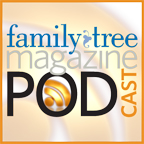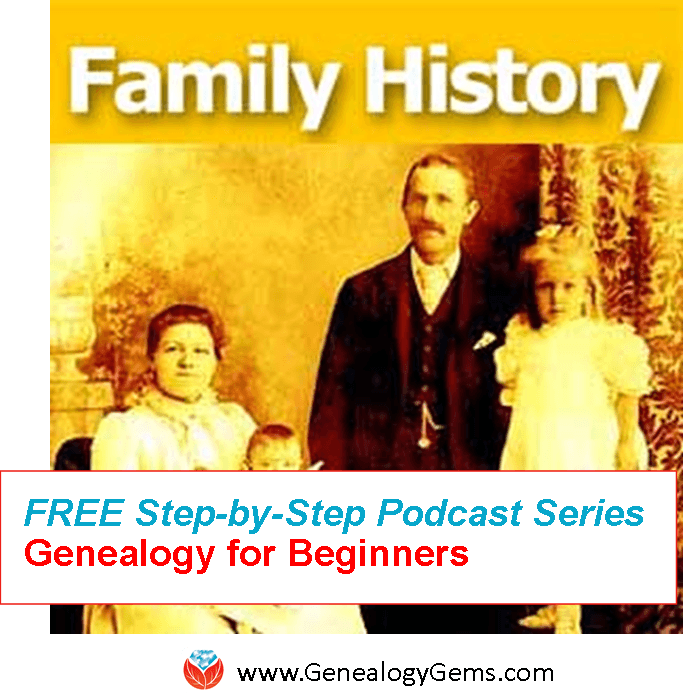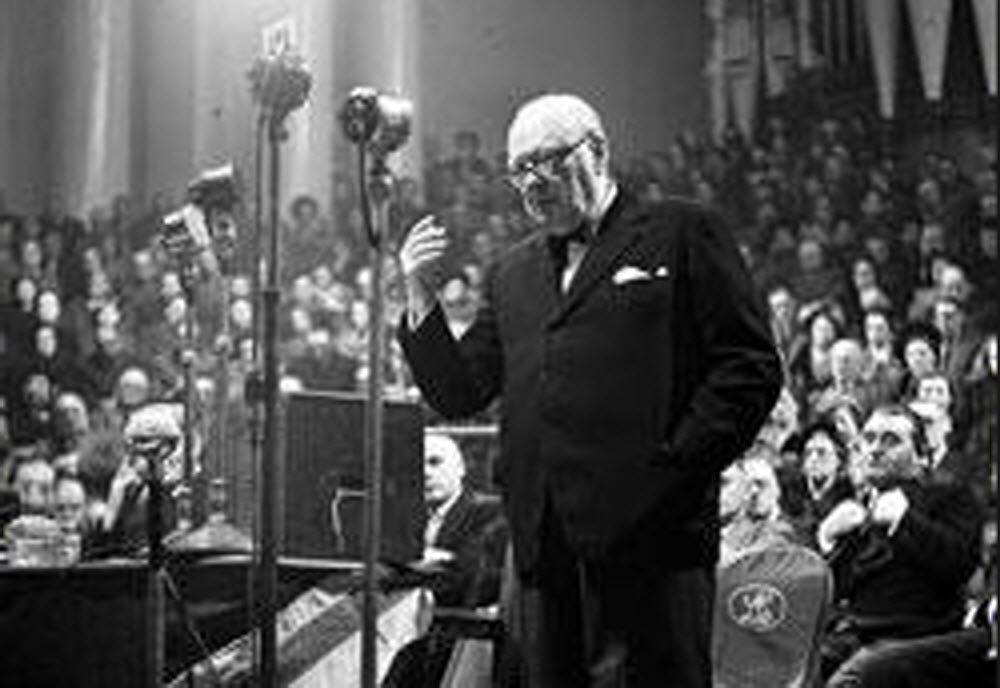by Lisa Cooke | Sep 23, 2014 | 01 What's New, Digital Archives, Family Tree Magazine, Organization, Preservation
 Autumn gives me the urge to organize and prepare for the future. That’s why I think the new Family Tree Magazine podcast episode is especially timely.
Autumn gives me the urge to organize and prepare for the future. That’s why I think the new Family Tree Magazine podcast episode is especially timely.
Lisa hosts the September 2014 Family Tree Magazine podcast with these highlights:
- News from the Blogosphere with Diane Haddad;
- Preservation tips from the Family Archivist columnist, Denise Levenick;
- Digital archiving websites from the current 101 Best Websites list;
- Genealogy estate planning with Family Tree University dean Tyler Moss;
- and roundup preparedness tips from Publisher Allison Dolan.
For more on disaster planning for genealogists, check out our four-part blog post series on it. Click here for the first one.
by Lisa Cooke | Sep 21, 2014 | 01 What's New, Collaborate, Evernote, Organization
Share notes with Evernote! It’s a simple and great way to collaborate with family and other genealogy researchers.
Mom always told you it was nice to share, and in the new Genealogy Gems Premium Video called Collaborative Genealogy with Evernote you’ll learn how to share notes with Evernote.
In fact, let’s get started with how to share note right now. The quickest way to learn is to see it in action, so here’s a five minute+ video from the class that will get you off to a great start.
As you can see, it’s easy to share notes with Evernote!
You may not always have time to make your way to a genealogy class or conference, but with Genealogy Gems Premium videos you can learn with your bunny slippers on whenever it’s convenient for you!  The half hour video presentation includes a downloadable handout with all the written instructions. Not a member yet? Become one here.
The half hour video presentation includes a downloadable handout with all the written instructions. Not a member yet? Become one here.
More Resources
Grab our Evernote for Genealogists quick reference here to have everything you need to know about setting up and using Evernote for genealogy research right at your fingertips.
How to Get Started in Evernote, and the Ultimate Evernote Education
by Lisa Cooke | Sep 17, 2014 | 01 What's New, Apps, History, Holidays, NARA
Today the United States celebrates Constitution Day! On this date in 1787–225 years ago–delegates finalized and signed the historic document that  became the U.S. Constitution.
became the U.S. Constitution.
In celebration, the National Archives Center for Legislative Archives has launched a free mobile app, e-book and even companion tools for teachers: lesson plans and teaching activities.
“Congress Creates the Bill of Rights” is described at the National Archives website, where you can download the e-book and teaching resources. The e-book is also available in iTunes and the iBookstore for iPad, iPhone, and iPod Touch. The app is available for download on iPad at the App Store.
A press release describes the app as “an interactive learning tool for tablets that lets the user experience the proposals, debates, and revisions that shaped the Bill of Rights in the First Congress. Its menu-based organization presents a historic overview, a one-stop source that includes the evolving language of each proposed amendment as it was shaped in the House and the Senate, a close-up look at essential documents, a ‘time-lapse’ display of the creation of the First Amendment, and more.
Congress Creates the Bill of Rights eBook presents a historic narrative focusing on James Madison’s leadership role in creating the Bill of Rights and effectively completing the Constitution. Starting with the crises facing the nation in the 1780s, the narrative traces the call for constitutional amendments from the state ratification conventions, and takes the reader inside Congress as the House and the Senate worked to formulate a set of amendments to send to the states.”
Did you have ancestors who were at the Constitutional Convention? Contribute what you know at the Signers of the U.S. Constitution Project at Geni.com. The goal of this project is to build “single, documented profiles” of those who signed.
by Lisa Cooke | Sep 16, 2014 | 01 What's New, Blogs, Inspiration, Listeners & Readers
Family History: Genealogy Made Easy

Listen to the Family History: Genealogy Made Easy podcast by Lisa Louise Cooke. It’s a great series for learning the research ropes and well as refreshing your skills.
with Lisa Louise Cooke
Republished 2014
[display_podcast]
Download the Show Notes for this Episode
Welcome to this step-by-step series for beginning genealogists—and more experienced ones who want to brush up or learn something new. I first ran this series in 2008-09. So many people have asked about it, I’m bringing it back in weekly segments.
Episode 45: Genealogy Blogs Started by YOU!
In recent episodes of this podcast, we’ve been talking about how and why to create a genealogy blog. In this episode I’m going to share some of the family history blogs that YOU—the listeners—have created. I’m hoping you’ll be inspired to blog by what others are doing, or that you’ll take note of any blogs that can help you or perhaps are relevant to your own family history. Being a community is what gives genealogists strengths and inspiration. Get your notepads out and get ready to jot down these terrific blogs!
Below are the blogs mentioned in the show. Most of them stayed active and have very recent posts! What a great thing to see the success they’ve had since getting started. There’s only one blog we didn’t find when we republished this episode: Teri’s blog on her Pomeranian ancestors.
Listeners’ Genealogy Blogs
Fermazin Family Ancestry by Nancy Peralta (NEW URL)
Leaves of the Tree by Kay Haden (NEW URL)
Are You My Cousin? by Lisa Lisson (NEW URL)
Kolbe Genealogy Blog by Michelle Kolbe
Finding the Flock—A Genealogy Research Blog by Sean Lamb
Gus’s Genealogy Blog by Gus Marsh
BELL family History – York W.A. by Graham Wilkie
New Genealogy Blogger Take-Away Tips:
- Beginning is the most important step!
- Writing up your brick walls and family groups is a great way to summarize in your mind where you are in your research, which often generates new leads.
- Try posting more articles to generate content for the search engines.
- Put your blog URL on message boards relating to your surname.
- Have you lost track of someone else’s blog that is no longer at its old URL? Search for the blog, the blogger’s name and other keywords (surnames, topics, places) to discover whether it’s migrated to a new URL. That’s how we located some of the blogs above when we republished this episode.
Starting a Genealogy Blog Q&A
(Please note that features and layouts of blogging platforms change over time. These answers were current as of the original podcast publication date. If things have changed, use clues from the answers to find the current answer!)
Question: I set up my blog in Blogger. There does not appear to be any spell checker. How is your blog set up in terms of writing and editing?
Answer: Yes, Blogger has a spell check. When you’re in Compose mode, there are buttons across the top of the Compose box. You’ll see Font, Bold, etc. There you will find an icon “ABC.” That’s the spell-checker. Click it and it will run while you’re in Compose mode.
Question: How do I insert the name of the site as a link without typing out the name of the URL? The URL is somehow encoded in the name of the link.
Answer: When links are embedded in the text, this is called a hyperlink. Highlight the text or the name you want to send people to. Then in the Compose box, you’ll see a little button that looks like the link of a chain. Just click that and you’ll get a window in which you can type in the complete web address where you’re sending people (I always go to the webpage I want to link to, copy the full URL and then paste it.)
Question: I set my blog as available to all, but a search even for the exact name of the blog doesn’t bring it up in my search engine. Why is that?
Answer: You can do a couple of things in your blog to help search engines notice you, but the reality is that perhaps Google hasn’t yet “crawled” your blog. Google combs and indexes website every day, and perhaps they haven’t gotten to you yet. You can go to Google.com/addurl, and there you can send your blog address to Google and that will get it indexed much more quickly. Get lots of new posts up with specific words (surnames, locations and other terms about your family).
by Lisa Cooke | Sep 11, 2014 | 01 What's New, Inspiration
“Those who cannot remember the past are condemned to repeat it.”
Santayana in The Life of Reason, 1905
One of the most important jobs we will have as family historians is passing on to the next generation our memories of September 11, 2001.
I’ll never forget my daughter Lacey calling me from the top of the stairs on that morning. She was listening to the radio as she prepared for school. “Mom,” she said, “I think you better turn on the TV. Something is happening.”
And like so many in America and around the world, I turned on the TV only to be glued to it into the wee hours of that night, devastated by the evil appearing on the screen.
The quote at the beginning of this article is often mistakenly attributed to Winston Churchill, but in fact, his statement to the House of Commons on May 2, 1935 after the Stresa Conference was even more thorough and extremely compelling:

“When the situation was manageable it was neglected, and now that it is thoroughly out of hand we apply too late the remedies which then might have effected a cure. There is nothing new in the story. It is as old as the sibylline books. It falls into that long, dismal catalogue of the fruitlessness of experience and the confirmed unteachability of mankind. Want of foresight, unwillingness to act when action would be simple and effective, lack of clear thinking, confusion of counsel until the emergency comes, until self-preservation strikes its jarring gong-these are the features which constitute the endless repetition of history.”
Learning from history and passing it on is key to our survival, as families, and as freedom-loving countries.
On this September 11 let’s pull our children and grandchildren close and be brave enough to share the reality of our experience. We, and future generations, need to remember.
God Bless America,
Lisa
 Autumn gives me the urge to organize and prepare for the future. That’s why I think the new Family Tree Magazine podcast episode is especially timely.
Autumn gives me the urge to organize and prepare for the future. That’s why I think the new Family Tree Magazine podcast episode is especially timely.


 became the U.S. Constitution.
became the U.S. Constitution.




